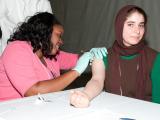Dec 3, 2012 (CIDRAP News) – The early uptick in flu infections that are predominantly the H3N2 strain shows some worrisome parallels to the nation's last bad regular flu season in 2003-04, officials from the US Centers for Disease Control and Prevention (CDC) said today.
The CDC's warning today that flu has picked up its pace about a month earlier than usual came during a media teleconference with reporters and at the start of its annual National Influenza Vaccination Week (NIVW), designed to encourage vaccination ahead of the main holiday season and the most active months for flu activity.
CDC Director Thomas Frieden, MD, MPH, said though influenza is notoriously unpredictable, there are early signs that it could be a bad year. "It's time to get vaccinated," he said, adding that one promising development is that about 90% of the circulating flu viruses are well matched to the strains contained in the seasonal flu vaccine.
The 2003-04 flu season was notable, because it struck earlier than normal, was more severe than the previous three seasons, and saw a poor match between the vaccine and circulating strains, mainly due to the arrival of a Fujian strain of H3N2, according to previous reports. Also, media outlets carried numerous reports of child flu deaths that season, which led the CDC to formalize gathering data on pediatric influenza deaths.
Heavy flu activity during the 2003-04 flu season also strained the nation's supply of flu vaccine, but officials this year don't anticipate any shortages. According to the most recent supply update from the CDC, vaccine manufacturers have distributed 120 million doses so far this season. Earlier this year manufacturers projected that they would make 135 million doses of flu vaccine for the US market.
The hint of a possibly severe flu season comes on the heels of an unusually mild and late flu season.
In its most recent flu surveillance update, released on Nov 30, the CDC said the percentage of doctor's visits for flulike illness hit the national baseline at the earliest point since the 2003-04 season, with much of the rise coming from south central and southern states.
Melinda Wharton, MD, acting director of the CDC's National Center for Immunization and Respiratory Diseases, told reporters that states seeing the highest flu activity levels are Tennessee, Mississippi, Alabama, Louisiana, and Texas. "It's a matter of time before higher levels are in the other states, as well."
The CDC also today released data it uses to gauge how uptake of flu vaccines is progressing. Frieden said so far the CDC is seeing increased rates in three key groups that are most vulnerable to influenza: children, pregnant women, and healthcare workers. Overall, the vaccination coverage data suggest that public officials are holding on to their gains from past years, but he added that officials hope to boost levels in the weeks ahead.
The data are from a CDC Internet panel survey of adults conducted from Nov 2 through Nov 15 and an ongoing telephone survey of parents from Oct 4 through Nov 17. The CDC said so far more than 60% of Americans haven't been vaccinated. Coverage in children ages 5 though 12, however, increased about 6 percentage points compared with the same time last season. In adults, vaccination was highest in adults older than age 65 and lowest in adults ages 18 though 49 years.
Among healthcare workers, vaccination levels were highest among pharmacists, physicians, nurses, and other clinical professionals. Frieden said he hopes vaccine campaigns will boost lagging levels in allied health workers, such as those who work in nursing homes.
The CDC's Internet survey of pregnant women showed that flu vaccination levels were slightly ahead of last season and found that those who were urged to be vaccinated at the doctor's office and were offered the chance to be vaccinated there were 1.6 times more likely to be vaccinated compared with those who received a doctor's recommendation only.
The CDC encouraged health providers to continue to recommend and offer the vaccine to pregnant women throughout the season.
A 2011 meta-analysis on flu vaccine efficacy in Lancet Infectious Disease concluded that the inactivate vaccine provided about 59% protection in healthy adults 64 years old and younger and that the vaccine-virus match made little difference in effectiveness. The authors said better flu vaccines are needed, but allowed that existing vaccines are still the best tool for preventing flu.
See also:
CDC national early-season flu vaccination coverage data
Nov 30 CDC flu surveillance update
CDC NIVW materials
Dec 3 CDC statement on flu activity, NIVW
















